|

< Back to Career archive
1969-1972: The GTV9 Lighting Department
I started work on 8 January 1969, wearing a suit on my first day. This was somewhat of a mistake, since I spent the next three weeks pulling lights apart, cleaning reflectors and lenses and lubricating lamp rails. However, by the time the production year started in February, I could re-assemble a Mole-Richardson 2K in the dark and hanging upside down from the grid! After learning to hang lights safely and set all the “lock-off” tensions so that the light could be quickly adjusted with a long pole afterwards, I graduated to operating the “floor-unit”, a mobile fill for feature performers which had to be tracked and adjusted so as to maintain even modelling on the performers’ face. A simple job at first glance, but the operator quickly learnt to visually judge fill levels and the art of negotiating a studio floor in a complex ballet involving two pedestal cameras, a camera crane, a sound boom and a multitude of performers.
I cut my teeth on “Kevin Dennis New Faces” before being let-loose on “In Melbourne Tonight”. Subsequent “promotions” led to differing tasks – follow spot operating, and then the patch panel. This was a large version of a telephone switchboard except that it carried lethal amounts of current. Each of the 370 studio outlets had a plug on a retractable cord and each of the 120 dimmers had a socket. Since the number of dimmers was insufficient for the number of lights in use, only the host set and the main centre-stage lighting spots stayed permanently patched, with the centre-stage set lighting patched as required from notes taken during the day and carefully recorded on the running sheet. Most commercial breaks had a cue for a re-patch in them and each repatch might involve up to twenty dimmer channels. Some of the cables carried up to 20 amps for the 5Kw lamps, and if you heard a fizzing noise accompanied by the smell of burning rubber, it was one of these patch plugs failing. There would be a loud “bang” and the cable would part and disappear down below the patch panel. If that lamp was required any further during the performance someone would have to go up into the grid and find a new outlet for it.
There were occasional “special” repatches as well. One was to unpatch the host set key light in the commercial break prior to “The Wilsons”, a comedy sketch featuring Graham Kennedy and Rosie Sturgess. The set change was done by moving the revolve on which the three main sets were built (host set, commercial set and the Wilsons’ set) through one hundred and twenty degrees. The normal host set key light was too narrow for the Wilson’s set, so there was a “Sputnik” hung next to it as a replacement. The “Sputnik” was wider and softer than a normal Mole-Richardson 2K and provided more coverage for action in the Wilsons’ set. One night I forgot this vital repatch. We came out of the break on the Wilson’s set and Graham made his entrance. He took one step forward, looked straight up into the key light which he immediately recognised as being incorrect, and frowned straight down the camera barrel at me watching the monitor at the patch panel. I realised my error immediately but it was too late to do anything. Graham went straight on with the sketch while I squirmed in horror. Only he, the Lighting Director and I probably realised that all was not quite right, but it was a mark of Graham’s professionalism that he was immediately aware of my mistake.
The Lighting Department also looked after certain special effects. One of my first jobs on IMT was to take part in a “running gag” that Graham had going for the Alka-Seltzer commercial. This involved such stunts as dropping the fizzy tablets from a height, or throwing them from a distance, which quite often strung out a supposedly 30-second live commercial for several minutes. No wonder the advertisers loved Graham! My part in the gag for that night was to take the “hero” bottle of Alka-Seltzer, open it carefully without destroying the label, and spray paint each individual tablet with matt white paint. Each tablet had to have several coats, and it took me all afternoon, carefully drying between each coat under a lamp. When done, the tablets were carefully repackaged and handed back to “commercial props”. That night, when delivered into the glass by Graham, the tablets just sat there and refused to fizz. As I remember, it got quite a laugh.
The other special effect delegated to the Lighting Department was the “flash pot”. No pyrotechnic licences were required in those days, so someone taught me to do it and I must have made hundreds of them over the years. The amount of gunpowder and external tape packaging could be varied to give a softer or louder bang depending on whether or not a loud detonation or a gentler puff smoke was the desired effect. I remember one night it was decided that after IMT we would pre-record a whole string of “cannon” blackouts (the 1812 overture gag with Graham as the muddling musician playing the “artillery”). I sat just off the set for several hours and, by the time one gag had been recorded; I had a fresh flash pot ready. That night just about wrecked that particular cannon, so a new one was ordered. This new cannon was very realistic and very well made. The first time it was used “live” Graham decided he wanted a really big flash pot. He got what he wanted. The cannon barrel disintegrated, one wheel went into the audience and one into the band. Graham swore audibly when it went off. The making of flash pots could have other unintended consequences. Shortly after “Division 4” started, a member of the Lighting Department was queuing in the ANZ bank in Burnley behind Divvy 4 lighting director John MacDowell. “Mac” was only one person from the teller when he casually informed his cohort in his characteristically loud voice that he had better get lots of gunpowder and detonators for Friday since we had a safe to blow up. Until his gaffe was pointed out to him afterwards, he couldn’t understand why the bank teller who served him was white and shaking!
“Mac” was known as the “Prince of Darkness” for his dramatic drama lighting, but I learnt a lot from him and fellow lighting directors John Fowler and Frits Bouwmeester.
Shortly after starting work at Nine I began to get very interested in lighting effects. In the late 1960s there was very little in the way of pre-made lighting affects other than a mirror ball or the Strand cloud and fire effects wheels. With fellow employees Mario Petri and Ian Whitelaw, I began to experiment. Mario was good at coming up with ways to make experimental mirror balls one of which was hemispherical, and you could put several on record turntables on the stage. Ian was an electronics wizard and came up with various devices to automatically control the speed of a flashing light. Together we begged and borrowed from GTV Facilities a video tape machine with insert editing and a camera and, on a day off, came in, put down an audio track, and laid down bursts of lighting effects until we had filled the tape in glorious monochrome (unfortunately, colour had yet to appear at GTV). That really started something. Within 24-hours bits of the tape had appeared on Mick Ivory’s station promos, and a week later the whole thing was used as a backing effect for a ballet on IMT. (The now famous choreographer Graeme Murphy was in the IMT staff ballet in those days). Soon we were experimenting with lighting effects even more – scrubbing the clouds off old Strand effects wheels, painting them with coloured lamp lacquer and partially washing it off again with methylated spirits dribbled onto it from height with an eye-dropper. Adding a breakup glass and a wide-angle lens to a Strand 252 projector produced very satisfying effects. Soon we were modifying slide projectors to blow bubbles through coloured liquids using fish-tank pumps. The colours we were able to achieve made this a bit frustrating in the days of black and white television, so the experimentation was moved off-station and into the live arena.
Co-incidentally, Martin Cooke, a teacher at Mount Waverley high school, began running a dance called “Spectra “in the Waverley high school hall where I had cut my teeth in lighting. This was well attended by locals, and had some quite good bands booked. The lighting was what was letting the event down, so I offered my services as lighting switcher. Soon, I had taken over the lighting completely. I built three rear-projection screens to go across the stage behind the band, skirting the bottom of them with black drapes to form a complete wall. I had three-phase power installed and started to buy some lights of my own to augment those owned by the school.
Overhead projectors were added to create moiré patterns and “wet-shows”, the latter consisting of immiscible liquids stained with food dye and “pulsed” using clock faces of differing radii. Ian Whitelaw built me some mammoth strobes to go out in the audience. I seconded some of my mates in the band I was in to do follow spot, and my sisters to dance on elevated tables behind the screens to throw shadows across the lighting effects. The dance grew and grew until thousands were attending and we had Billy Thorpe and the Aztecs permanently booked to close the show. I’d like to think that some of that success was due to my lighting. The photo shows me at the lighting console at “Spectra” in 1970. Only two years had passed since the photo taken at the same place while still in school uniform. What a difference a couple of years makes...
Meanwhile, I had specified and Ian Whitelaw was building me a dedicated effects lighting console. To my knowledge, this was the first of its type in Australia. For the technically minded, it had 12 x 2kW dimmers, the first six of which could be audio-modulated by miking the individual instrument. The musician then modulated his own “special” with his sound. All 12 channels had 3-position paddle switches – up was full on, centre was off and down was to the set dimmer level. In the down position they were spring-loaded and could be played like piano keys – in effect the first “flash-buttons” in Australia. There were also six channels of variable speed “flip-flop” flashers and six channels of line patch for strobes, mirror ball motors etc. There was a master blackout switch and phase metering so that an eye could be kept on loads, and an individually dimmed work light. Later improvements included a talkback system to the follow spot and wet-show operators and a dedicated strobe driver. Ian did a great job on this console, with a linished, anodised and engraved front panel and a veneered case. Meanwhile, I registered the name “Entertainment Services and Promotions” and was actively trading as the ESP lightshow. For the uninitiated, at this time bands seldom travelled with their own lighting crew. (Ross Wilson’s “Pink Finks” was an early exception). Instead, a promoter booked the bands through an agent, the band agency sorted out whose (or what combination) of sound systems the bands would use, and the promoter decided which lighting company to book. There wasn’t much choice in the early 1970s – my ESP Lightshow, Roger Foley’s Ellis D. Fogg (from Sydney, a brief Melbourne “franchise” of which was run by John Pinder), and the McSpedden Brothers’ Edison Lightshow (later Giant Edison Screw) spring to mind although, as the seventies progressed, others like John McKissock’s Clearlight Shows joined in. As you can see, all of us were more or less influenced by the substances available for personal ingestion at the time...
There was an added benefit of working at GTV. At the rear of the premises was a recording studio know as Television City Sound (TCS for short). Mostly it was used to record backing tracks for IMT. However, a new audio console built for the OB department by Melbourne firm Optronics was installed here and whenever the console was not needed for an OB, the studio was hired out to bands. Late one night in early 1971 after completing the set-up for a Yooralla telethon, I was on my way out to the car park when a familiar sound caught my ears as I passed the doors of TCS. I was already into the Blues and buying Robert Johnson, Sleepy John Estes and Howling Wolf records from Discurio. The band in the studio was Chain, and I was a huge fan from seeing them at clubs like Berties on the corner of Flinders Lane and Spring Street. This was too good an opportunity to miss. I wandered in the side door, introduced myself and offered to get some lights for them. TCS was pretty basic at that stage and all the lighting was fluorescent tubes. I dragged in some lights and the Lighting Department’s small stock of gel to colour them, and managed to improve the ambience somewhat. This resulted in an invitation to stay for the rest of the recording and the offer of something to smoke. Naturally I accepted. As a result, the very ripped and rather flat “we’re groanin” in the left channel of the album version of “Black and Blue” is a very tired member of the GTV Lighting Department who probably performed at less than his optimum on the opening of the Telethon a few hours later. It was a great night, the only discordant note (apart from my vocal) being an argument between the band and engineer John Sayer over the amount of bass on the tracks being laid down. Since the monitoring at TCS at that stage was a rather tired pair of horn-loaded Altec A7 cabinets better suited to a country picture theatre, the lack of bass was probably a perception rather than a reality.
Next page >
|
 |

A young Frits Bouwmeester in
the lighting crane at GTV9 in
1958. He is focusing a Mole
Richardson 2K - a task with
which I was to become very
familiar!
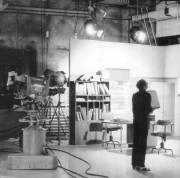
Alan Hardess taking down patch outlet numbers for the “Vicker’s Office” set on “Division 4”
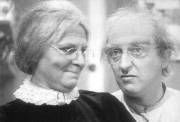
Rosie Sturgess and Graham
Kennedy in “The Wilsons”
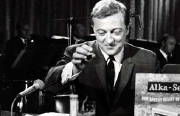
The series of long-running ads for Alka Seltzer provided Graham with the opportunity to run a new gag with each show – I was lucky enough to have had a small part in one of these
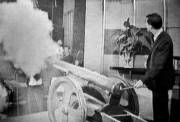
One of a series of cannon gags – a young Pete Smith in the foreground bombards Graham (hidden by the smoke)
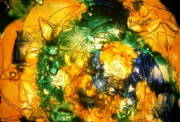
An early lighting effect for an overhead projector – Perspex painted with lamp lacquer onto which was drizzled Araldite in an “almost-set” condition
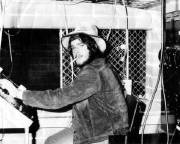
Peter at the lighting switchboard at “Spectra ‘70” at Waverley High School in 1970 – note the bank of resistance dimmers on the right – today these would be a collectable antique!
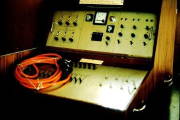
The custom lighting console built by Ian Whitelaw to my specification was very likely the first in Australia to boast “flash buttons”
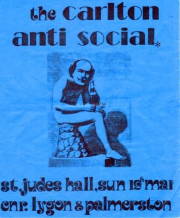

The front cover of an advertising leaflet for the “Carlton Anti-Social” and, inside, a credit for the ESP lightshow
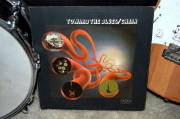
Chain’s “towards the Blues” – an important early album for the Mushroom label
|
